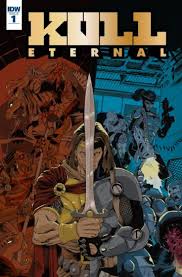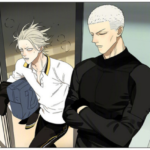
Kull Eternal #1
Written by: Tom Waltz
Art by: Luca Pizzari
Colors by: Triona Tree Farrell
Published by: IDW
A review by Stacy Dooks
 Most people begin their exploration of fantasy fiction with J.R.R. Tolkien’s Lord of the Rings, and to be fair that’s not a bad place to start. The oxford don casts a long shadow over classic Western fantasy tropes, but he wasn’t the only person to craft mythic worlds set in times long ago. Robert E. Howard was a pulp writer in the 1930s who crafted an entire mythic era all his own–the Hyborian Age–that served as the backdrop to the adventures of his most enduring creation: Conan of Cimmeria, more popularly known as Conan the Barbarian. But Conan wasn’t Howard’s first attempt at a hero who rose from savage roots to become a king by his own hand. His first creation, King Kull of Valusia, was the prototype for the character Conan would later become: a barbaric warrior who deposes a tyrannical king and takes his crown, only to find that such power comes with a price. Howard wrote a handful of stories featuring Kull, but they were impressive enough that the character has endured in reprint collections and comics ever since. Which brings us to the first issue of Kull Eternal, a story that takes the barbarian king in an intriguing new direction that I didn’t quite see coming.
Most people begin their exploration of fantasy fiction with J.R.R. Tolkien’s Lord of the Rings, and to be fair that’s not a bad place to start. The oxford don casts a long shadow over classic Western fantasy tropes, but he wasn’t the only person to craft mythic worlds set in times long ago. Robert E. Howard was a pulp writer in the 1930s who crafted an entire mythic era all his own–the Hyborian Age–that served as the backdrop to the adventures of his most enduring creation: Conan of Cimmeria, more popularly known as Conan the Barbarian. But Conan wasn’t Howard’s first attempt at a hero who rose from savage roots to become a king by his own hand. His first creation, King Kull of Valusia, was the prototype for the character Conan would later become: a barbaric warrior who deposes a tyrannical king and takes his crown, only to find that such power comes with a price. Howard wrote a handful of stories featuring Kull, but they were impressive enough that the character has endured in reprint collections and comics ever since. Which brings us to the first issue of Kull Eternal, a story that takes the barbarian king in an intriguing new direction that I didn’t quite see coming.
The story opens in present day Antarctica, where Kull and his companions Brule and Zarunna are aiding soldiers in mowing down serpent men with machine guns-
Mm?
Oh, the serpent men are longtime foes of Kull. They feature prominently in his debut story “The Shadow Kingdom.” It’s actually pretty interesting, the serpent men can’t say a certain eldritch phrase and so you can find them out if they’re disguised as humans and –
Oh. You meant the present day, machine guns bit. Well it seems that Kull Eternal finds our hero following the trail of the serpent men and their evil not only through the world of Ancient Valusia, but from the distant past to our present day. The how and the why is something the discerning reader will have to find out for themselves, but needless to say as openings go it sure got my attention. Howard explored the notion of reincarnation and time travel in some of his stories, so to see it put to use here in an adventure that may span the sum of human history is definitely a switch from the usual story cycle of Kull fighting to retain his throne.
It’s clear that Tom Waltz knows his material (he references the Howard classic “The Mirrors of Tuzan Thune” as an inspiration for this series), and he deftly plays with the reader in Kull Eternal, first by kicking the door in and upending your expectations and then playing to those expectations with the foreknowledge that something big is going to happen to turn this sword and sorcery tale on its ear. I haven’t encountered Luca Pizarri’s art before but it’s arresting stuff, conveying the action of the battle sequences clearly while also delivering on the epic scope and spectacle a story like this needs. Triona Farrel’s colors work to enhance the mood, whether the cold and grim world of the present or the opulent world of ancient Valusia, the book’s colors and art feel of a piece with the older Kull comics from Marvel.
If I have one minor quibble though, I have to say that Pizarri’s take on Kull isn’t quite what I see when I think of the character. But when you’re following in the footsteps of artists like John Buscema, Bernie Wrightson, Sal Buscema, Charles Vess, and Will Conrad I can understand the desire to make the character’s look distinctive.
The Verdict:
Buy It! If you’re looking for some Game of Thrones meets The Thing by way of Back to the Future style fun, Kull Eternal is the mini-series you need on your to-read pile.



